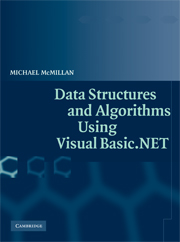Book contents
- Frontmatter
- Contents
- Preface
- Introduction
- Chapter 1 Collections
- Chapter 2 Arrays and ArrayLists
- Chapter 3 Basic Sorting Algorithms
- Chapter 4 Basic Searching Algorithms
- Chapter 5 Stacks and Queues
- Chapter 6 The BitArray Class
- Chapter 7 Strings, the String Class, and the StringBuilder Class
- Chapter 8 Pattern Matching and Text Processing
- Chapter 9 Building Dictionaries: The DictionaryBase Class and the SortedList Class
- Chapter 10 Hashing and the HashTable Class
- Chapter 11 Linked Lists
- Chapter 12 Binary Trees and Binary Search Trees
- Chapter 13 Sets
- Chapter 14 Advanced Sorting Algorithms
- Chapter 15 Advanced Data Structures and Algorithms for Searching
- Chapter 16 Graphs and Graph Algorithms
- Chapter 17 Advanced Algorithms
- References
- Index
Chapter 13 - Sets
Published online by Cambridge University Press: 11 August 2009
- Frontmatter
- Contents
- Preface
- Introduction
- Chapter 1 Collections
- Chapter 2 Arrays and ArrayLists
- Chapter 3 Basic Sorting Algorithms
- Chapter 4 Basic Searching Algorithms
- Chapter 5 Stacks and Queues
- Chapter 6 The BitArray Class
- Chapter 7 Strings, the String Class, and the StringBuilder Class
- Chapter 8 Pattern Matching and Text Processing
- Chapter 9 Building Dictionaries: The DictionaryBase Class and the SortedList Class
- Chapter 10 Hashing and the HashTable Class
- Chapter 11 Linked Lists
- Chapter 12 Binary Trees and Binary Search Trees
- Chapter 13 Sets
- Chapter 14 Advanced Sorting Algorithms
- Chapter 15 Advanced Data Structures and Algorithms for Searching
- Chapter 16 Graphs and Graph Algorithms
- Chapter 17 Advanced Algorithms
- References
- Index
Summary
A set is a collection of unique elements. The elements of a set are called members. The two most important properties of sets are that the members of a set are unordered and that no member can occur in a set more than once. Sets play a very important role in computer science but are not included as a data structure in VB.NET.
This chapter discusses the development of a Set class. Rather than provide just one implementation, however, we provide two. For nonnumeric items, we provide a fairly simple implementation using a hash table as the underlying data structureThe problem with this implementation is its efficiency. A more efficient Set class for numeric values utilizes a bit array as its data store. This forms the basis of our second implementation.
FUNDAMENTAL SET DEFINITIONS, OPERATIONS, AND PROPERTIES
A set is defined as an unordered collection of related members in which no member occurs more than once. A set is written as a list of members surrounded by curly braces, such as {0,1,2,3,4,5,6,7,8,9}. We can write a set in any order, so the previous set can be written as {9,8,7,6,5,4,3,2,1,0} or any other combination of the members such that all members are written just once.
Set Definitions
Here are some definitions you need to know to work with sets:
A set that contains no members is called the empty set. The universe is the set of all possible members.
Two sets are considered equal if they contain exactly the same members.
A set is considered a subset of another set if all the members of the first set are contained in the second set.
- Type
- Chapter
- Information
- Data Structures and Algorithms Using Visual Basic.NET , pp. 268 - 282Publisher: Cambridge University PressPrint publication year: 2005



